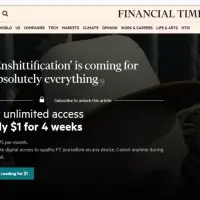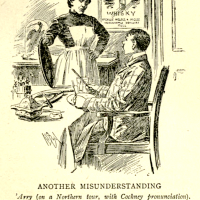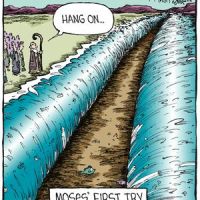 One of the hottest new shows on Netflix is The OA. A genre-bending serial of 8 rough-hewn episodes, it has the transdimensional framework and Scoobie gang dynamics of Stranger Things, but a much more adult narrative. While Stranger Things uses 1980s pop culture to create a home of the viewer—and then turns that home inside out—The OA is playing with a blend of spiritual and technological elements that bend the viewer’s expectations to the point of breaking.
One of the hottest new shows on Netflix is The OA. A genre-bending serial of 8 rough-hewn episodes, it has the transdimensional framework and Scoobie gang dynamics of Stranger Things, but a much more adult narrative. While Stranger Things uses 1980s pop culture to create a home of the viewer—and then turns that home inside out—The OA is playing with a blend of spiritual and technological elements that bend the viewer’s expectations to the point of breaking.
I don’t have a full understanding of how the speculative universe of The OA works yet. For the most part, I think this is a feature of the storytelling. We do not know in Stranger Things whether or Eleven is the beast, or has taken the beast inside herself, or whether it is the Christ motif of self-sacrifice at work. The last, rushed few minutes of Stranger Things lays some groundwork for season 2, desperately expected but still a ways away. Rather than a summer repeat it will be a Halloween special, which is cool in its own way.
 The OA also leaves things intentionally open. Part of this is an unusual technique of serial filmmaking. The episodes are radically different in length (ranging from 30 to 70 minutes). The opening credits of the first episode don’t even roll until 45 minutes in. Yet that first 45 minutes is not a prelude, but the baseline reality that serves as host to the story-within-a-story. It is one of the more obvious story-within-a-story set ups I have seen in recent history, where we literally have a storytelling circle. More than a technique, it is the power dynamic both of the unusual Scoobie gang—a Breakfast Club collective, each with his, or her, or their own competing tensions—and of the speculative framework as a whole. To the extent that we can believe the speculative world that is presented to us—more of that in a moment—the story itself is about power: either spiritual power, or a new technology, or both.
The OA also leaves things intentionally open. Part of this is an unusual technique of serial filmmaking. The episodes are radically different in length (ranging from 30 to 70 minutes). The opening credits of the first episode don’t even roll until 45 minutes in. Yet that first 45 minutes is not a prelude, but the baseline reality that serves as host to the story-within-a-story. It is one of the more obvious story-within-a-story set ups I have seen in recent history, where we literally have a storytelling circle. More than a technique, it is the power dynamic both of the unusual Scoobie gang—a Breakfast Club collective, each with his, or her, or their own competing tensions—and of the speculative framework as a whole. To the extent that we can believe the speculative world that is presented to us—more of that in a moment—the story itself is about power: either spiritual power, or a new technology, or both.
Like Stranger Things and some other new film, much of the beauty of the filmmaking is in a kind of ugliness—what a Japanese poet might call wabi sabi. You have to give yourself in to the protagonist’s tale or you will be in danger of laughing at the wrong moment or rolling your eyes and going to do your taxes or something useful. Everything hinges on our belief in the protagonist. We must surrender to the story, which is the very choice the central characters are given in both the story and the story-within-a-story.
 It is this dynamic that I think is the most brilliant feature of The OA. This film is a perfect context for dealing with the way that we assess the claims of faith. As their reasons for abandoning loyalty increase, the motley crew of heroes—including the people that they are surrogates for in the story-within-a-story—must decide whether or not they believe the tale. The story is grand, coherent, almost irresistible and completely unbelievable. People who have grown up in church (or synagogue, or mosque) cannot understand how disorienting the story of God really is. Like the heroes of The OA—indeed, like every person viewing the film—when the story of faith comes our way, we must in the end choose against all cultural improbability the too-good-to-be true gospel with all its seeming impossibilities.
It is this dynamic that I think is the most brilliant feature of The OA. This film is a perfect context for dealing with the way that we assess the claims of faith. As their reasons for abandoning loyalty increase, the motley crew of heroes—including the people that they are surrogates for in the story-within-a-story—must decide whether or not they believe the tale. The story is grand, coherent, almost irresistible and completely unbelievable. People who have grown up in church (or synagogue, or mosque) cannot understand how disorienting the story of God really is. Like the heroes of The OA—indeed, like every person viewing the film—when the story of faith comes our way, we must in the end choose against all cultural improbability the too-good-to-be true gospel with all its seeming impossibilities.
One scene captures the cultural incongruity of faith perfectly. There is a moment where the protagonist and her listeners are lost in her story and a neighbourhood search party walks in. To those in the circle it has been a compelling and heartbreaking tale, and each one feels the betrayal and abandonment, the hopelessness and the miracle that seemed to come just when it was too late. They all felt the intimacy of love’s first and last touch, and that not every death has a resurrection.
There, in that moment of full faith and trust, the perspective suddenly shifts. To the townsfolk who stumble in on this spiritual circle, they see a severely mentally ill woman shredding her clothes with a knife, weeping in her underwear in an abandoned house in the presence of gender-confused and socially isolated minors while a schoolteacher watched on in wide-eyed fascination.
 The audience suddenly sees: the beauty of this group is really quite horrifying when viewed by those who have not shared a bond of trust. We had forgotten the horror as we lost ourselves in the story. For the people on the outside it is clearly about molestation, abuse, and a betrayal of the faith and hope of youth. At best, it is a victimized women now preying on the lonely, confused, isolated, and vulnerable.
The audience suddenly sees: the beauty of this group is really quite horrifying when viewed by those who have not shared a bond of trust. We had forgotten the horror as we lost ourselves in the story. For the people on the outside it is clearly about molestation, abuse, and a betrayal of the faith and hope of youth. At best, it is a victimized women now preying on the lonely, confused, isolated, and vulnerable.
For those on the inside it is a tragic exposure. It is like having our phone hacked, our intimate journal shared online, our prayer life broadcast on the radio, our bed turned into a weapon by a lover.
This brilliant moment highlights that difficult inside-outside relationship of faith and culture in a parable on the psychology of religion with a richness I have rarely seen before. More than the parable, the film itself enacts the central spiritual dynamic of Christian faith: that we must surrender all, die to self, give ourselves over to that which we cannot fully understand. To those who, in C.S. Lewis’ terms in An Experiment in Criticism, surrender to the text, The OA is a compelling and troubling tale. To those who do not or cannot surrender—to those who cannot buy in to the film—I cannot see how it can be anything but silly. This is the folly of faith.
 This shocking idea of the faith choice is not the only spiritual dynamic, and it is probably not the one that most would think of. Other spiritual dynamics sit at the front of the visual storytelling, including one of the brilliant examples of a Christ motif I’ve seen in contemporary film. We don’t know yet if Stranger Things is a Christ tale, but The OA is soaked through with Christian imagery repackaged in non-Christian spiritual forms—a dynamic that we saw in Doctor Strange. Questions of sin and liberation, betrayal and trust, doubt and hope are all centred around the image of the cross and the discovery of new life in the morning.
This shocking idea of the faith choice is not the only spiritual dynamic, and it is probably not the one that most would think of. Other spiritual dynamics sit at the front of the visual storytelling, including one of the brilliant examples of a Christ motif I’ve seen in contemporary film. We don’t know yet if Stranger Things is a Christ tale, but The OA is soaked through with Christian imagery repackaged in non-Christian spiritual forms—a dynamic that we saw in Doctor Strange. Questions of sin and liberation, betrayal and trust, doubt and hope are all centred around the image of the cross and the discovery of new life in the morning.
All of this is set within a storytelling machine that is not Christian, but the spiritual-technological transdimensional framework that is still unclear (to me at least). This obscuring of mythic core is probably not the intentional embedding of worldview—sneaking past watchful dragons of culture—but is more likely instinctive, a product of culture rather than design. I doubt the writers are trying to retell the story of the cross or Buddhism or any rooted faith perspective. I’m not sure the writers of The OA themselves even understand the speculative world they have built/are in the midst of building. They are, however, deeply aware of the central theme and core messages. It is a “teleological” film: The OA is going somewhere. The lines converge, though not all of them, and I don’t think the spiritual dynamics are entirely accidental.
 There are critical weaknesses in the show that sit awkwardly with its fascinating elements. The last two episodes have gaps—core spaces that are unexplained not because we don’t have the full truth about the elements of that fictional world, but careless missing links after 6 episodes of intensely careful storytelling. There are two nudity scenes that sit awkwardly in the 6 hours of film. These scenes—both playing on sexist tropes—each have a core moral lesson that works well in either plot or character dynamic. A sex scene in each case is the right choice. Because of how they are filmed they become unnecessary to the whole and part of a series of moments that make the series feel amateurish. Similarly, the use of a gypsy wagon decorated green screen stage for the “elsewhere” shots seemed liked they were trying too hard.
There are critical weaknesses in the show that sit awkwardly with its fascinating elements. The last two episodes have gaps—core spaces that are unexplained not because we don’t have the full truth about the elements of that fictional world, but careless missing links after 6 episodes of intensely careful storytelling. There are two nudity scenes that sit awkwardly in the 6 hours of film. These scenes—both playing on sexist tropes—each have a core moral lesson that works well in either plot or character dynamic. A sex scene in each case is the right choice. Because of how they are filmed they become unnecessary to the whole and part of a series of moments that make the series feel amateurish. Similarly, the use of a gypsy wagon decorated green screen stage for the “elsewhere” shots seemed liked they were trying too hard.
Some of these inelegant features may be surprises for season two, such as an unclear “call” dynamic, what appears to be a deus ex machina framework for the use of technology, and gaps here and there in character development. I am hopeful that that we will cross the threshold into a sustained, integrated world, but I think some of this is either production bungling, or making it up as you go along.
We’ll see. This is a largely untested crew—in fact the intriguing situation where some indie art producers, including the lead actress, have written a sophisticated SF series and kept the best risk elements we want in non-mainstream film. Netflix should be watching for this sort of thing, though it can (and will eventually) descend into hipsteristic mainstreamery, such as the fake 90s edge films that followed Reality Bites and Empire Records. So we have a window here where people like Brit Marling and Zal Batmanglij can make The OA, or the Duffer Brothers can make Stranger Things. Another generation or two of copying will turn it into garbage. (By the way, is it just me or are those names—Marling, Batmanglij, and Duffer—almost too good to be true?)
Until then, I will mull the question: is Homer on the other side of dark?





















